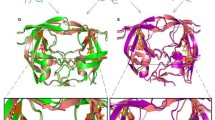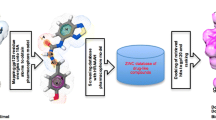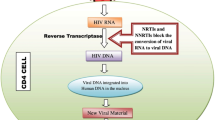Abstract
The aspartate protease of the human immune deficiency type-1 virus (HIV-1) has become a crucial antiviral target in which many useful antiretroviral inhibitors have been developed. However, it seems the emergence of new HIV-1 PR mutations enhances drug resistance, hence, the available FDA approved drugs show less activity towards the protease. A mutation and insertion designated L38L↑N↑L PR was recently reported from subtype of C-SA HIV-1. An integrated two-layered ONIOM (QM:MM) method was employed in this study to examine the binding affinities of the nine HIV PR inhibitors against this mutant. The computed binding free energies as well as experimental data revealed a reduced inhibitory activity towards the L38L↑N↑L PR in comparison with subtype C-SA HIV-1 PR. This observation suggests that the insertion and mutations significantly affect the binding affinities or characteristics of the HIV PIs and/or parent PR. The same trend for the computational binding free energies was observed for eight of the nine inhibitors with respect to the experimental binding free energies. The outcome of this study shows that ONIOM method can be used as a reliable computational approach to rationalize lead compounds against specific targets. The nature of the intermolecular interactions in terms of the host–guest hydrogen bond interactions is discussed using the atoms in molecules (AIM) analysis. Natural bond orbital analysis was also used to determine the extent of charge transfer between the QM region of the L38L↑N↑L PR enzyme and FDA approved drugs. AIM analysis showed that the interaction between the QM region of the L38L↑N↑L PR and FDA approved drugs are electrostatic dominant, the bond stability computed from the NBO analysis supports the results from the AIM application. Future studies will focus on the improvement of the computational model by considering explicit water molecules in the active pocket. We believe that this approach has the potential to provide information that will aid in the design of much improved HIV-1 PR antiviral drugs.





Similar content being viewed by others
References
Hensen C et al (2004) A combined QM/MM approach to protein-ligand interactions: polarization effects of the HIV-1 protease on selected high affinity inhibitors. J Med Chem 47(27):6673–6680
Shehu-Xhilaga M, Oelrichs R (2009) Basic HIV virology. In: HIV management in Australasia, Australian Society for HIV Medicine, Surry Hills, pp. 9–18
Brik A, Wong C-H (2003) HIV-1 protease: mechanism and drug discovery. Org Biomol Chem 1(1):5–14
Pearl LH, Taylor WR (1987) A structural model for the retroviral proteases. Nature 329(6137):351–354
Mildner AM et al (1994) The HIV-1 protease as enzyme and substrate: mutagenesis of autolysis sites and generation of a stable mutant with retained kinetic properties. Biochemistry 33(32):9405–9413
Braz AS et al (2012) Relation between flexibility and positively selected HIV-1 protease mutants against inhibitors. Proteins 80(12):2680–2691
Bonini C et al (2010) Synthesis of new thienyl ring containing HIV-1 protease inhibitors: promising preliminary pharmacological evaluation against recombinant HIV-1 proteases. J Med Chem 53(4):1451–1457
Mager PP (2001) The active site of HIV-1 protease. Med Res Rev 21(4):348–353
Clavel F, Mammano F (2010) Role of gag in HIV resistance to protease inhibitors. Viruses 2(7):1411–1426
Deeks SG et al (1997) HIV-1 protease inhibitors: a review for clinicians. Jama 277(2):145–153
Mitsuya H, Yarchoan R, Broder S (1990) Molecular targets for AIDS therapy. Science 249(4976):1533–1544
Katz RA, Skalka AM (1994) The retroviral enzymes. Annu Rev Biochem 63(1):133–173
Li D et al (2011) Strength of hydrogen bond network takes crucial roles in the dissociation process of inhibitors from the HIV-1 protease binding pocket. PLoS ONE 6(4):e19268
Kramer R et al (1986) HTLV-III gag protein is processed in yeast cells by the virus pol-protease. Science 231(4745):1580–1584
Huff JR (1991) HIV protease: a novel chemotherapeutic target for AIDS. J Med Chem 34(8):2305–2314
Hohlfeld K et al (2015) Disubstituted bis-THF moieties as new P2 ligands in nonpeptidal HIV-1 protease inhibitors (II). J Med Chem 58(9):4029–4038
Genoni A et al (2010) Computational study of the resistance shown by the subtype B/HIV-1 protease to currently known inhibitors. Biochemistry 49(19):4283–4295
Robbins AH et al (2010) Structure of the unbound form of HIV-1 subtype A protease: comparison with unbound forms of proteases from other HIV subtypes. Acta Crystallogr Sect D 66(3):233–242
Mosebi S et al (2008) Active-site mutations in the South African human immunodeficiency virus type 1 subtype C protease have a significant impact on clinical inhibitor binding: kinetic and thermodynamic study. J Virol 82(22):11476–11479
Verheyen J et al (2009) Prevalence of C-terminal gag cleavage site mutations in HIV from therapy-naive patients. J Infect 58(1):61–67
Hodge CN et al (1996) Improved cyclic urea inhibitors of the HIV-1 protease: synthesis, potency, resistance profile, human pharmacokinetics and X-ray crystal structure of DMP 450. Chem Biol 3(4):301–314
Brown D et al (2005) Antiviral activity of steric-block oligonucleotides targeting the HIV-1 trans-activation response and packaging signal stem-loop RNAs. Nucleosides Nucleotides Nucleic Acids 24(5–7):393–396
Nijhuis M et al (2007) A novel substrate-based HIV-1 protease inhibitor drug resistance mechanism. PLoS Med 4(1):e36
Lampejo T, Pillay D (2013) HIV virology, testing and monitoring. Medicine 41(8):420–424
Mao Y (2011) Dynamical basis for drug resistance of HIV-1 protease. BMC Struct Biol 11(1):1
Palmisano L, Vella S (2011) A brief history of antiretroviral therapy of HIV infection: success and challenges. Annali dell’Istituto superiore di sanità 47(1):44–48
Liu Z et al (2013) Insights into the mechanism of drug resistance: X-ray structure analysis of multi-drug resistant HIV-1 protease ritonavir complex. Biochem Biophys Res Commun 431(2):232–238
Honarparvar B et al (2012) Pentacycloundecane-diol-based HIV-1 protease inhibitors: biological screening, 2D NMR, and molecular simulation studies. ChemMedChem 7(6):1009–1019
Makatini MM et al (2013) Synthesis, 2D-NMR and molecular modelling studies of pentacycloundecane lactam-peptides and peptoids as potential HIV-1 wild type C-SA protease inhibitors. J Enzyme Inhib Med Chem 28(1):78–88
Honarparvar B et al (2013) Integrated approach to structure-based enzymatic drug design: molecular modeling, spectroscopy, and experimental bioactivity. Chem Rev 114(1):493–537
Pawar SA et al (2012) Synthesis and molecular modelling studies of novel carbapeptide analogs for inhibition of HIV-1 protease. Eur J Med Chem 53:13–21
Pawar SA et al (2013) Linear and cyclic glycopeptide as HIV protease inhibitors. Eur J Med Chem 60:144–154
Karpoormath R et al (2012) Pentacycloundecane derived hydroxy acid peptides: a new class of irreversible non-scissile ether bridged type isoster as potential HIV-1 wild type C-SA protease inhibitors. Bioorg Chem 40:19–29
Makatini MM et al (2012) Synthesis, screening and computational investigation of pentacycloundecane-peptoids as potent CSA-HIV PR inhibitors. Eur J Med Chem 57:459–467
Karpoormath R et al (2013) Novel PCU cage diol peptides as potential targets against wild-type CSA HIV-1 protease: synthesis, biological screening and molecular modelling studies. Med Chem Res 22(8):3918–3933
Ahmed SM et al (2013) Comparison of the molecular dynamics and calculated binding free energies for nine FDA-approved HIV-1 PR drugs against subtype B and C-SA HIV PR. Chem Biol Drug Des 81(2):208–218
Lockhat HA et al (2015) Binding free energy calculations of nine FDA-approved protease inhibitors against HIV-1 subtype C I36T↑ T containing 100 amino acids per monomer. Chem Biol Drug Des 87:487–498
Ahmed SM et al (2014) The impact of active site mutations of South African HIV PR on drug resistance: insight from molecular dynamics simulations, binding free energy and per-residue footprints. Chem Biol Drug Des 83(4):472–481
Frisch A, Foresman J (1996) Exploring chemistry with electronic structure methods, vol 302. Gaussian Inc, Pittsburgh
Vreven T, Morokuma K (2000) On the application of the IMOMO (integrated molecular orbital + molecular orbital) method. J Comput Chem 21(16):1419–1432
Vreven T, Morokuma K (2006) Hybrid methods: Oniom (qm: mm) and qm/mm. Annu Rep Comput Chem 2:35–51
Sanusi Z et al (2017) Investigation of the binding free energies of FDA approved drugs against subtype B and C-SA HIV PR: ONIOM approach. J Mol Graph Model 76:77–78
Maseko SB et al (2017) I36T↑ T mutation in South African subtype C (C-SA) HIV-1 protease significantly alters protease-drug interactions. Biol Chem. https://doi.org/10.1515/hsz-2017-0107
Fong P et al (2009) Assessment of QM/MM scoring functions for molecular docking to HIV-1 protease. J Chem Inform Model 49(4):913–924
Saen-oon S et al (2007) Insight into analysis of interactions of saquinavir with HIV-1 protease in comparison between the wild-type and G48V and G48V/L90M mutants based on QM and QM/MM calculations. J Mol Graph Model 26(4):720–727
Wittayanarakul K et al (2005) Insights into saquinavir resistance in the G48V HIV-1 protease: quantum calculations and molecular dynamic simulations. Biophys J 88(2):867–879
Shi S et al (2009) Molecular dynamics simulations on the role of protonation states in HIV-1 protease-indinavir complex. Acta Chim Sin 67:2791–2797
Tong Y et al (2009) Quantum calculation of protein solvation and protein–ligand binding free energy for hiv-1 protease/water complex. J Theor Comput Chem 8(06):1265–1279
Makatini MM (2011) Design, synthesis and screening of novel PCU-peptide/peptoid derived HIV protease inhibitors. University of KwaZulu-Natal, Westville
Smith R et al (1996) Ionization states of the catalytic residues in HIV-1 protease. Nat Struct Mol Biol 3(11):946–950
Honarparvar B et al (2015) Pentacycloundecane lactam vs lactone norstatine type protease HIV inhibitors: binding energy calculations and DFT study. J Biomed Sci 22(1):1–15
Maseko SB et al (2016) Purification and characterization of naturally occurring HIV-1 (South African subtype C) protease mutants from inclusion bodies. Protein Expr Purif 122:90–96
Bader RF (1990) Atoms in molecules. Wiley Online Library
Popelier P (2000) Atoms in molecules: an introduction. Harlow, Pearson Education
Reed AE, Curtiss LA, Weinhold F (1988) Intermolecular interactions from a natural bond orbital, donor-acceptor viewpoint. Chem Rev 88(6):899–926
Dahiya S, Gahlaut A, Kulharia M (2013) Comparative evaluation of commercially available homology modelling tools: a structural bioinformatics perspective. Drug Invent Today 5(3):207–211
Weber IT (1990) Evaluation of homology modeling of HIV protease. Proteins 7(2):172–184
Maghsoudi AH et al (2011) Homology modeling, docking, molecular dynamics simulation, and structural analyses of coxsakievirus B3 2A protease: an enzyme involved in the pathogenesis of inflammatory myocarditis. Int J Biol Macromol 49(4):487–492
Dhanavade MJ et al (2013) Homology modeling, molecular docking and MD simulation studies to investigate role of cysteine protease from Xanthomonas campestris in degradation of Aβ peptide. Comput Biol Med 43(12):2063–2070
Kohn W, Becke AD, Parr RG (1996) Density functional theory of electronic structure. J Phys Chem 100(31):12974–12980
Neumann R, Nobes RH, Handy NC (1996) Exchange functionals and potentials. Mol Phys 87(1):1–36
Becke AD (1993) Density-functional thermochemistry. III. The role of exact exchange. J Chem Phys 98(7):5648–5652
Lee C, Yang W, Parr RG (1988) Development of the Colle-Salvetti correlation-energy formula into a functional of the electron density. Phys Rev B 37(2):785–789
Hariharan PC, Pople JA (1973) The influence of polarization functions on molecular orbital hydrogenation energies. Theor Chim Acta 28(3):213–222
Rassolov VA et al (1998) 6-31G* basis set for atoms K through Zn. J Chem Phys 109(4):1223–1229
Case DA et al (2005) The Amber biomolecular simulation programs. J Comput Chem 26(16):1668–1688
Studio D (2013) 4.0 Tutorials. Receptor-Ligand Interaction. Accelrys Inc, San Diego
Laskowski RA, Swindells MB (2011) LigPlot+: multiple ligand–protein interaction diagrams for drug discovery. J Chem Inform Model 51(10):2778–2786
Biegler-König F, Schönbohm J (2002) Update of the AIM2000-Program for atoms in molecules. J Comput Chem 23(15):1489–1494
Kuiper BD et al (2015) The L33F darunavir resistance mutation acts as a molecular anchor reducing the flexibility of the HIV-1 protease 30 s and 80 s loops. Biochem Biophys Rep 2:160–165
Liu Z et al (2013) Crystallographic study of multi-drug resistant HIV-1 protease lopinavir complex: mechanism of drug recognition and resistance. Biochem Biophys Res Commun 437(2):199–204
Kuhnert M, Steuber H, Diederich WE (2014) Structural basis for HTLV-1 protease inhibition by the HIV-1 protease inhibitor indinavir. J Med Chem 57(14):6266–6272
Tie Y et al (2012) Critical differences in HIV-1 and HIV-2 protease specificity for clinical inhibitors. Protein Sci 21(3):339–350
Kožíšek M et al (2007) Molecular analysis of the HIV-1 resistance development: enzymatic activities, crystal structures, and thermodynamics of nelfinavir-resistant HIV protease mutants. J Mol Biol 374(4):1005–1016
Yedidi RS et al (2014) A conserved hydrogen-bonding network of P2 bis-tetrahydrofuran-containing HIV-1 protease inhibitors (PIs) with a protease active-site amino acid backbone aids in their activity against PI-resistant HIV. Antimicrob Agents Chemother 58(7):3679–3688
King NM et al (2012) Extreme entropy–enthalpy compensation in a drug-resistant variant of HIV-1 protease. ACS Chem Biol 7(9):1536–1546
DeLano WL (2002) The PyMOL molecular graphics system. DeLano Scientific, San Carlos
Cole JC et al (2005) Comparing protein–ligand docking programs is difficult. Proteins 60(3):325–332
Gohlke H, Hendlich M, Klebe G (2000) Knowledge-based scoring function to predict protein-ligand interactions. J Mol Biol 295(2):337–356
Kontoyianni M, McClellan LM, Sokol GS (2004) Evaluation of docking performance: comparative data on docking algorithms. J Med Chem 47(3):558–565
Li H, Robertson AD, Jensen JH (2005) Very fast empirical prediction and rationalization of protein pKa values. Proteins 61(4):704–721
Dolinsky TJ et al (2004) PDB2PQR: an automated pipeline for the setup of Poisson–Boltzmann electrostatics calculations. Nucleic Acids Res 32(suppl 2):W665-W667
Dennington R, Keith T, Millam J (2009) Semichem Inc, vol 5. Shawnee Mission KS, GaussView, Version
Vreven T et al (2006) Combining quantum mechanics methods with molecular mechanics methods in ONIOM. J Chem Theory Comput 2(3):815–826
Morokuma K (2002) New challenges in quantum chemistry: quests for accurate calculations for large molecular systems. Philos Trans Royal Soc Lond A 360(1795):1149–1164
Vreven T et al (2003) Geometry optimization with QM/MM, ONIOM, and other combined methods. I. Microiterations and constraints. J Comput Chem 24(6):760–769
Dapprich S et al (1999) A new ONIOM implementation in Gaussian98. Part I. The calculation of energies, gradients, vibrational frequencies and electric field derivatives. J Mol Struct (Thoechem) 461:1–21
Parr RG, Yang W (1984) Density functional approach to the frontier-electron theory of chemical reactivity. J Am Chem Soc 106(14):4049–4050
Johnson BG, Gill PM, Pople JA (1993) The performance of a family of density functional methods. J Chem Phys 98(7):5612–5626
Kapp J, Remko M, Schleyer PvR (1996) H2XO and (CH3)2XO compounds (X = C, Si, Ge, Sn, Pb): double bonds vs carbene-like structures can the metal compounds exist at all?. J Am Chem Soc 118(24):5745–5751
Remko M, Walsh OA, Richards WG (2001) Theoretical study of molecular structure, tautomerism, and geometrical isomerism of moxonidine: two-layered ONIOM calculations. J Phys Chem A 105(28):6926–6931
Frisch M et al (2009) 09, Revision D. 01, Gaussian, Inc., Wallingford, CT
Lundberg M et al (2010) Case studies of ONIOM (DFT: DFTB) and ONIOM (DFT: DFTB: MM) for enzymes and enzyme mimics. J Chem Theory Comput 6(4):1413–1427
Chung LW et al (2015) The ONIOM method and its applications. Chem Rev 115(12):5678–5796
Priya AM, Senthilkumar L, Kolandaivel P (2014) Hydrogen-bonded complexes of serotonin with methanol and ethanol: a DFT study. Struct Chem 25(1):139–157
Kosenkov D et al (2008) Tautomeric equilibrium, stability, and hydrogen bonding in 2′-deoxyguanosine monophosphate complexed with Mg2+. J Phys Chem B 112(1):150–157
Senthilkumar L, Ghanty TK, Ghosh SK (2005) Electron density and energy decomposition analysis in hydrogen-bonded complexes of azabenzenes with water, acetamide, and thioacetamide. J Phys Chem A 109(33):7575–7582
Hao M-H (2006) Theoretical calculation of hydrogen-bonding strength for drug molecules. J Chem Theory Comput 2(3):863–872
Kotena ZM et al (2013) Hydrogen bonds in galactopyranoside and glucopyranoside: a density functional theory study. J Mol Model 19(2):589–599
Popelier P (1998) Characterization of a dihydrogen bond on the basis of the electron density. J Phys Chem A 102(10):1873–1878
Mosapour Kotena Z, Behjatmanesh–Ardakani R, Hashim R (2014) AIM and NBO analyses on hydrogen bonds formation in sugar-based surfactants (α/β-d-mannose and n-octyl-α/β-d-mannopyranoside): a density functional theory study. Liq Cryst 41(6):784–792
Popelier P, Bader R (1992) The existence of an intramolecular C·H·O hydrogen bond in creatine and carbamoyl sarcosine. Chem Phys Lett 189(6):542–548
Iwaoka M et al (2004) Nature of nonbonded Se⊙⊙⊙ O interactions characterized by 17O NMR spectroscopy and NBO and AIM analyses. J Am Chem Soc 126(16):5309–5317
Kheirjou S, Mehrpajouh S, Fattahi A (2013) Drastic influence of boron atom on the acidity of alcohol in both gas phase and solution phase, A DFT Study. J Theor Comput Chem 12(01):1250103
Kheirjou S, Fattahi A, Hashemi MM (2014) The intramolecular cation–π interaction of some aryl amines and its drastic influence on the basicity of them: AIM and NBO analysis. Comput Theor Chem 1036:51–60
Arnold WD, Oldfield E (2000) The chemical nature of hydrogen bonding in proteins via NMR: J-couplings, chemical shifts, and AIM theory. J Am Chem Soc 122(51):12835–12841
Lu Y-X et al (2007) Ab initio investigation of the complexes between bromobenzene and several electron donors: some insights into the magnitude and nature of halogen bonding interactions. J Phys Chem A 111(42):10781–10788
Matta CF, Boyd RJ (2007) An introduction to the quantum theory of atoms in molecules. In: The quantum theory of atoms molecules: from solid state to DNA and drug design. Wiley, Weinheim
Foster J, Weinhold F (1980) Natural hybrid orbitals. J Am Chem Soc 102(24):7211–7218
Weinhold F, Landis CR (2005) Valency and bonding: a natural bond orbital donor-acceptor perspective. Cambridge University Press, Cambridge
Majerz I (2012) Directionality of inter-and intramolecular OHO hydrogen bonds: DFT study followed by AIM and NBO analysis. J Phys Chem A 116(30):7992–8000
Behjatmanesh-Ardakani R (2015) NBO–NEDA, NPA, and QTAIM studies on the interactions between aza-, diaza-, and triaza-12-crown-4 (An-12-crown-4, n = 1, 2, 3) and Li+, Na+, and K + ions. Comput Theor Chem 1051:62–71
Ryde U (2014) A fundamental view of enthalpy–entropy compensation. MedChemComm 5(9):1324–1336
Nazari F, Doroodi Z (2010) The substitution effect on heavy versions of cyclobutadiene. Int J Quantum Chem 110(8):1514–1528
Acknowledgements
We thank the College of Health Sciences (CHS), Aspen Pharmacare, MRC and the NRF for financial support. We are also grateful to the CHPC (http://www.chpc.ac.za) and UKZN HPC cluster as our computational resources.
Author information
Authors and Affiliations
Corresponding authors
Ethics declarations
Competing interests
The authors declare that they have no competing interests.
Electronic supplementary material
Below is the link to the electronic supplementary material.
Rights and permissions
About this article
Cite this article
Sanusi, Z.K., Govender, T., Maguire, G.E.M. et al. An insight to the molecular interactions of the FDA approved HIV PR drugs against L38L↑N↑L PR mutant. J Comput Aided Mol Des 32, 459–471 (2018). https://doi.org/10.1007/s10822-018-0099-9
Received:
Accepted:
Published:
Issue Date:
DOI: https://doi.org/10.1007/s10822-018-0099-9




